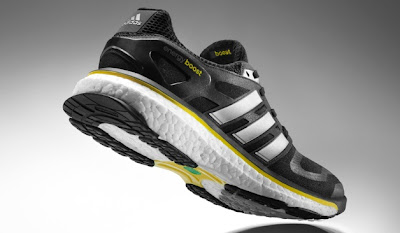Adidas Energy Boost Technology
The Adidas shoe making a buzz around the running community is the new Energy Boost. People have claimed the shoe actually gives them an advantage while running. Displays in stores allow you to drop two separate steel balls straight down on the Boost material and the more widely used EVA material (PU is another material used). Pause.
EVA? Ethylene-vinyl acetate (a copolymer of 10-40% vinyl acetate and the rest ethylene). It's the material that is used in many shoes these days. In fact, it has a massive range of uses. Adidas even uses it to manufacture the Adidas Jabulani football/soccerball. EVA works well in low temperatures, is stress-crack resistant, and is UV radiation resistant.
PU? Polyurethane. I've heard some old Adidas shoes and Ecco shoes use this material. I hate polyurethanes because they are made using an isocyanate and a polyol. Isocyanates irritate my skin, lungs, eyes, you name it. I am sensitized to that terrible stuff...
When I went into the store the other day, one of the workers and local runners told me that the shoes are in such high demand/new/rare, that they (the workers) were not allowed to purchase them yet. The shoes, I was told, have material in them that is only made in Germany. Super high tech, science stuff. Price tag is even Boosted up to $150 (see what I did there?). This brings me back to the display.
As the steel balls in the display hit the EVA or the Boost material, they bounce back up. The steel ball on the Boost material bounces higher than the steel ball on the EVA material. Great, huh? Soft. Bouncy. It must make me run more awesome.
In my head, all the little buzzers started going off and my cogs started to turn. I'm a pretty skeptical person. I blame my enjoyment for science. I decided to investigate this material. It must be pretty awesome if it is from Germany. Seriously, Ritter Sport chocolate is the best chocolate I have ever tasted from a wrapper. Ritter Sport is from Germany.
A quick Google search led me to articles about the latest Energy Boost, how it feels to run in, and speculations about any restrictions on racing in the shoe. Amby Burfoot's article even addresses the ASTM! Being part geek, I agreed with Amby's perspective and wished Instron, MTS, or Tinius Olsen would make a machine that would be better suited to test shoes as if a human was wearing them. I immediately imagined a new ASTM and numerous studies that would have to be done on runners, terrain, and how runners react to running on different surfaces. A quick look into the ASTM revealed ASTM F 1614, "Standard Test Method for Shock Attenuating Properties of Materials Systems for Athletic Footwear" as a seemingly suitable test measure. Instron has a machine for this, one of the ElectroPuls Test Instruments, to be used with WaveMatrix Dynamic Test Software. They even have a page showing how it would test athletic shoes.
Newton used Knight Mechanical Testing (http://www.knighttesting.com/
Newton used Knight Mechanical Testing (http://www.knighttesting.com/
Back to the shoes. I was more interested in the actual material. Almost every article that talked about the science of the material included this sentence:
"...solid granular material (TPU) is literally blown up and turned into small energy capsules..."
I quickly looked up TPU--thermoplastic polyurethane.
According to Wikipedia,
"Technically, they are thermoplastic elastomers consisting of linear segmented block copolymers composed of hard and soft segments."
"Technically, they are thermoplastic elastomers consisting of linear segmented block copolymers composed of hard and soft segments."
I am a little worried about the material, depending on if it is polyester-based or polyether-based TPU. Check out the table on Wikipedia to see the strengths and weaknesses of each: http://en.wikipedia.org/wiki/
Suddenly, I see a name I recognize: BASF - The Chemical Company.
"Recently, BASF has pioneered crosslinking during TPU production, made possible by adding liquid crosslinkers and using a masterbatch."
This name was also mentioned in the Adidas Group press release (pdf). I searched BASF for more information on this new running material, but all I found was this:
"MDI
MDI stands for diphenylmethane diisocyanate and is one of the most important raw materials for the production of the plastic polyurethane. This plastic is used for applications ranging from the soles of high-tech jogging shoes, to car shock-absorbers, refrigerator insulation and even insulation for buildings."
MDI stands for diphenylmethane diisocyanate and is one of the most important raw materials for the production of the plastic polyurethane. This plastic is used for applications ranging from the soles of high-tech jogging shoes, to car shock-absorbers, refrigerator insulation and even insulation for buildings."
This Internet browsing thing started delving a little deep into the chemistry, so I have decided to do some more research later on blowing up TPU and then making them into small energy capsules (I have a funny image in my head of that). I don't know if MDI is involved with these shoes or not (probably the older Adidas shoes). I then started to feel pretty stupid because I realized how little I know about polymers and polymer production, so I will take a class or two on polymers and physics.


Comments
Post a Comment